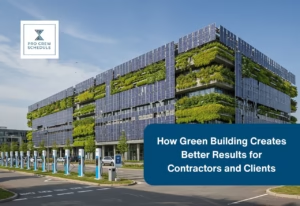In the construction industry, the most sought-after output of any project owner can be simplified in one solid word— quality. Some say that the end justifies the means, but in construction, the completed structure and the process it went through to get there are just as important. This is why strict quality control and quality assurance construction projects need to go through to ensure an output worth presenting to the owner.
The question now is: what happens when quality is not prioritized, or worse, neglected in construction? Then you should expect construction defects to manifest. It is incredibly helpful to learn not only to pursue quality but also to dodge defects as these two opposite spectrums are very well connected.
In today’s blog, let’s dive in a little deeper on various construction defects that you may encounter in managing construction projects, how to classify them, and which team is liable for owning up to the manifested issues in the project.
When Do Construction Defects Occur?
A construction defect happened whenever a completed or partially finished structure fails to perform as required by accepted building standards or applicable construction contracts. It is typically a concrete column that is structurally deficient, a bridge whose cables snap or flex, roofing insulation won’t absorb heat, a paint that cracks, or adhesives that do not bond are some of the examples of construction defects.
What is Considered as A Construction Defect?
1. Obvious vs. Hidden Defects
Construction defects can be categorized into two major categories: obvious and hidden. Defects like, under strengthened concrete, undersized beams, or pain coating applications are usually apparent and easy during construction when the team liability is transparent and the cost of rectification is minimal.
Commonly, however, construction defects are hidden. A hidden defect manifest during the construction phase but is undetected until after (or even years after) a project is completed and the structure and its functions are in use. One example would be a structural column that meets the specified grade, size, and color requirements but is understrength.
Hidden defects can also be progressive – meaning, over time, the deficiency gradually worsens as the structure or its functions are subject to natural forces or material deterioration. Examples also include concrete that continually deteriorates over changing weather and seasons, flooring that gives way due to gradual loss of supporting adhesives, and leaking roofing that over time causes damage to structural components of a building and mold growth.
2. Defect vs. Sign of Defect
A construction defect is often different from the sign of the defect, even though both must be corrected. The sign of defect is the apparent condition of the structure, its components, or the defective materials caused by the defect, indicating an even severe problem. For instance, although a stucco wall crack may appear to be a defect, it is just a sign of the defect. The actual defect might be inadequate structural support, substandard materials, incorrect subsurface preparation, or missing expansion joints.
It is essential to categorize both the signs of the defect and the defect itself because rectifying only the symptoms will not correct the real problem. One of the ways to prevent the last minute or too late detection of the sign of defects is adding regular punch listing in the daily construction log of your team, even during the operation stage. After all, prevention is better than solutions.
What Are The Types of Construction Defects?
In a nutshell, a construction defect is any element in a structure that fails to conform to the contract specifications or perform as expected. There are various types of construction defects, including:
1. Diversion from Project Plans and Specifications
A construction project is built based upon plans and specifications that tell the general contractor what to construct and the type of materials to use. Construction plans include the drawings prepared but the following people that are approved by the professional design team.
- Architect – Perspective, Floor Plans, Elevation Plans, and other schematics
- Surveyor – Lot Plan and Survey
- MEP Engineers – Mechanical Plans, Electrical Plans, Plumbing Plans
- Consulting Engineers – Structural Plans
- Contractors or Supplier – Shop Drawings
The Project Specification, which is usually provided by the design team, which is included in the plans, presents details that are not evident in the drawings, such as performance aspects, types and quality of materials to be used, and the method and processes to be employed in the operations.
No matter how expensive or high-grade material is, it is still considered a defect if it is diverted from what is required from the project plans and specifications.
2. The Structure or its Component Does Not Work as Intended
A construction defect is when a structure or any of its parts do not function as intended. This included falling short of performance criteria imposed in the specifications (like a concrete slab in the 3rd storey having a certain psi of strength), an unexpected failure in a part of a structure (like a bent steel I-Beam column supporting the roof trusses), or any aspect of the construction project that just doesn’t work as is should (such as plumbing leaks, inadequate power in electrical provisions, or excessive soil settlement.
3. Violation of The Building Code
All construction, no matter how small or big, no matter the purpose, must comply with the building and the safety standard imposed by the law. Even if a structure works or functions as planned, failure to comply with any of the provisions in the Building Code constitutes a defect in the construction design or work. For instance, inadequate space in the stairs landing for an egress building may “function correctly” in the sense that people can still use it but still violates the fire code.
3. Early Deterioration
Early, or sometimes called “premature,” deterioration of an element in a project may be an aftereffect of construction defect. An example would be a steel door intended to last 30 years that starts deteriorating (like showing signs of corrosion) after just five years.
However, some early deterioration may not be a construction defect, depending on how it occurs in the whole construction timeline or even after the project is handed over to the owner. For example, manifesting moisture in a fully painted wall completed three months earlier is most likely a sign of construction defect, such as a leak coming from the ceiling. But if the same excess moisture appeared after the wall was painted, it likely is not a defect but a natural result of wear and tear or even poor maintenance.
Who Is Responsible for Construction Defects?
1. Contractor’s Responsibility
The general contractor team is responsible for performing the project scope as needed to complete the structure, and even construction crew management delegates tasks to ensure efficient day-to-day operations. The general contractor hires the subcontractors to carry out the trade-specific job, orders the materials and equipment needed, and maintains the project inventory throughout the construction operations. The obligation of a GenCon is defined in contracts signed at the beginning of the project, which also serves as a reference for liability if the GenCon fails to perform as expected.
Even though a contractor who delivers according to the project plans and specifications is generally not liable for the project defects, an exception is when a contractor knows that the plans and specifications were defective in the first place. A contractor who is well aware of the technical precautions of flawed plans and specs should bring light the issues to the owner’s attention before conducting any work.
2. Designer’s Responsibility
Whatever the design role (architect or engineer), a design professional who fails to implement a keen eye and reasonable care and judgment in performing tasks may be responsible for construction defects. One solid example is a structural engineer who fails to consider critical factors in the design and miscalculates the loads for a structure, leading to structural failure.
Additionally, design professionals are required to regularly inspect actual worksites to check compliance to construction plans and specs as to defects that could have been detected early on to prevent more significant problems in the future.
3. Owner’s Responsibility
Most project owners think they are immune to any liability related to construction defects. In their eyes, the designer produces plans and specs, and the general contractor builds the project based on these; however, some of the defects are the owner’s responsibility.
For instance, a project owner provides incorrect information to the designers and contractors, leading to severe stricture failure in the long run. Construction contracts also explicitly say that all project details must be accurate as imposed by law.
Furthermore, a project owner is responsible for maintaining a finished project to prevent post-construction defects and failures that might result in overtime due to deferred or neglected maintenance.
Key Takeaway
Project management for construction is about preventing defects from manifesting during the construction operations and ensuring that no defects will show after the project has been handed over to the owner.
In construction, there are many things we absolutely cannot control; however, we must strictly identify all the aspects that we can maintain and do our best to prevent unnecessary headaches in the years to come.







